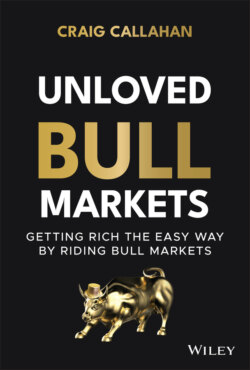Unloved Bull Markets

Реклама. ООО «ЛитРес», ИНН: 7719571260.
Оглавление
Craig Callahan. Unloved Bull Markets
Table of Contents
List of Tables
List of Illustrations
Guide
Pages
Unloved Bull Markets. Getting Rich the Easy Way by Riding Bull Markets
Preface
Acknowledgments
About the Author
Introduction
Chapter 1 “Unloved” Bull Markets
Investor Sentiment
Public Funds Pension Plans and Endowments
Anecdotal Examples of Unloved
Confidence
Yields Suggest “Unloved”
Other Assets
Does Rate of Return Matter?
Top Ten Reasons I Missed the Bull Market
Unloved? Why?
Chapter 2 Was the Bull Market Sensible?
Annual Returns
Sectors and Volatility
Earnings
Value
Down Days
Similar Crashes, Similar Recoveries
Summary
Chapter 3 News and Stock Prices
Industry-Specific News
Expectations
Chapter 4 Economic Setting
Europe
China
Economic Surprises
Summary
Chapter 5 Inflation and Interest Rates
Stuck in the 1970s
Phony, Fabricated, and Dangerous
Negative Interest Rates
Negative Interest Rates Explained … And Not So Scary
Why Didn't the Easy Monetary Policy Ignite Inflation?
Capacity Utilization
2009 Outlook
Inflation Following a Recession
Velocity of Money
Are Low Interest Rates Rational and Normal?
Summary
Chapter 6 The Federal Reserve and Monetary Policy
Money Supply
Europe and China
Peak Conditions
Is There a Market Peak and Subsequent Bear Market in Sight?
Neutral Monetary Policy
M1 Not Rates
Summary
Chapter 7 Unemployment
Unemployment Statistics Don't Tell You How to Invest
Spending Leads Employment
Phillips Curve
Relax—We Are on a Good Phillips Curve
Summary
Chapter 8 Betting on a Lackluster Stock Market and Higher Interest Rates
Chapter 9 Volatility Events
1990 and 1998
CNBC TV
Value
Setbacks and Theme Reversals
Accepting the Stock Market as It Is
Why Can't the Market Adapt to My Needs?
Summary
Chapter 10 Six Pieces of Bad Information
Overpriced?
Deficiencies of P/E in Predicting Returns
Deflation
We Do Not Worry About Deflation. Here's Why
Corporate Buybacks
Portfolio Update
Summary
Lackluster Revenue Growth and Earnings
Corporate Debt
Bond Bubble? Are US Corporations Using Excessive Amounts of Debt?
Summary
Inverted Yield Curve
Summary
Chapter 11 Active-Passive
Market Capitalization
Value–Growth
Pace
Changing Market Conditions
Behavioral Finance
Passive Investing's Dark Side
How Passive Investing Interferes with Our Free Market System
Summary
Chapter 12 Strategies
Ten Investment Strategies
Competitive Position
Economic Conditions
Future Growth
Market Conditions
Opportunity
Profitability
Quantitative
Risk
Social Considerations
Valuation
Classifying by Strategy
Performance
Factors
Strategies Contributed to “Unloved”?
Summary
Chapter 13 Human Behavior
Short Sellers
Human Behavior–Economic Forecasting
Want to Relive It?
Final Quiz
Chapter 14 And Then It Ended with a Crash
Stock Market Crash
Abnormal Peak
Stunning Visual
Chapter 15 I Want My Money Back
Unloved Rebound
Money Market Fund Assets
Why Claims “The Market Was Expensive” Were Wrong
Sectors
Strategies
Monetary Policy
Pace
Down Days
Economic Surprise
Unemployment
Value and Sentiment
Top Ten Reasons
Summary
Chapter 16 Conclusion
Perceived Uncertainty
Gains versus Losses
Type 1, Type 2
Half Empty–Partly Cloudy
When Will It End?
Index
WILEY END USER LICENSE AGREEMENT
Отрывок из книги
Craig Callahan
For decades I have been telling financial advisors and investors “rallies and bull markets don't issue invitations” and “rallies and bull markets don't look like rallies and bull markets” … until they are over. An old Wall Street saying is that “stocks climb a wall of worry.” We are in an imperfect world and there is always something to worry about. This book will help financial advisors and investors focus on the profitable climb instead of the worries.
.....
In previous bull markets, if the market was higher one day, there would be more buying the next day by momentum investors. It is often referred to as “fear of missing the boat” as it is pulling away from the dock. In a bull market it is usually a terrible feeling seeing the market move higher while holding cash. During this bull market, however, if the market was higher on a day the next day saw a sell-off thirty to sixty minutes into the trading day. It felt like investors, not realizing we were in a bull market, felt the advance the day before gave them a chance to get out. So to move higher two days in a row, buyers had to take out the weak jittery money.
One metric used by investors who use technical analysis is comparing the number of issues that advance each day to the number that decline. If over a recent period of, say, ten or thirty days a lot more issues are advancing than declining, there are two interpretations. One is that the advance has breadth and is sustainable. The other is that the market is “overbought” and will soon turn and go lower. Commentary during the bull market typically favored the negative view as the market was labeled “overbought.” It appears that the analyst's predetermined bearish bias influenced the interpretation of the data.
.....